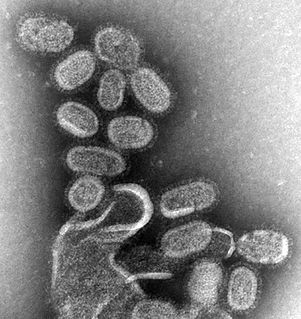This article needs more medical references for verification or relies too heavily on primary sources .(June 2015) |
| Avian avulavirus 1 | |
|---|---|
 | |
| Avian avulavirus 1 (stained in brown) in the conjunctiva of a chicken | |
| Virus classification | |
| (unranked): | Virus |
| Phylum: | Negarnaviricota |
| Class: | Monjiviricetes |
| Order: | Mononegavirales |
| Family: | Paramyxoviridae |
| Genus: | Avulavirus |
| Species: | Avian avulavirus 1 |
Newcastle disease is a contagious viral bird disease affecting many domestic and wild avian species; it is transmissible to humans. [1] It was first identified in Java, Indonesia, in 1926, and in 1927, in Newcastle-upon-Tyne, England (whence it got its name). However, it may have been prevalent as early as 1898, when a disease wiped out all the domestic fowl in northwest Scotland. [2] Its effects are most notable in domestic poultry due to their high susceptibility and the potential for severe impacts of an epizootic on the poultry industries. It is endemic to many countries.

Birds, also known as Aves, are a group of endothermic vertebrates, characterised by feathers, toothless beaked jaws, the laying of hard-shelled eggs, a high metabolic rate, a four-chambered heart, and a strong yet lightweight skeleton. Birds live worldwide and range in size from the 5 cm (2 in) bee hummingbird to the 2.75 m (9 ft) ostrich. They rank as the world's most numerically-successful class of tetrapods, with approximately ten thousand living species, more than half of these being passerines, sometimes known as perching birds. Birds have wings which are more or less developed depending on the species; the only known groups without wings are the extinct moa and elephant birds. Wings, which evolved from forelimbs, gave birds the ability to fly, although further evolution has led to the loss of flight in flightless birds, including ratites, penguins, and diverse endemic island species of birds. The digestive and respiratory systems of birds are also uniquely adapted for flight. Some bird species of aquatic environments, particularly seabirds and some waterbirds, have further evolved for swimming.

A disease is a particular abnormal condition that negatively affects the structure or function of part or all of an organism, and that is not due to any external injury. Diseases are often construed as medical conditions that are associated with specific symptoms and signs. A disease may be caused by external factors such as pathogens or by internal dysfunctions. For example, internal dysfunctions of the immune system can produce a variety of different diseases, including various forms of immunodeficiency, hypersensitivity, allergies and autoimmune disorders.

Zoonoses are infectious diseases caused by bacteria, viruses and parasites that spread between animals and humans.
Contents
- Causal agent
- Strains
- Use as an anticancer agent
- Transmission
- Clinical findings
- Clinical signs
- Postmortem lesions
- Diagnosis
- Immunological tests
- Virus isolation
- Prevention
- References
- External links
Exposure of humans to infected birds (for example in poultry processing plants) can cause mild conjunctivitis and influenza-like symptoms, but the Newcastle disease virus (NDV) otherwise poses no hazard to human health. Interest in the use of NDV as an anticancer agent has arisen from the ability of NDV to selectively kill human tumour cells with limited toxicity to normal cells.

Conjunctivitis, also known as pink eye, is inflammation of the outermost layer of the white part of the eye and the inner surface of the eyelid. It makes the eye appear pink or reddish. Pain, burning, scratchiness, or itchiness may occur. The affected eye may have increased tears or be "stuck shut" in the morning. Swelling of the white part of the eye may also occur. Itching is more common in cases due to allergies. Conjunctivitis can affect one or both eyes.

Influenza, commonly known as the flu, is an infectious disease caused by an influenza virus. Symptoms can be mild to severe. The most common symptoms include: high fever, runny nose, sore throat, muscle pains, headache, coughing, sneezing, and feeling tired. These symptoms typically begin two days after exposure to the virus and most last less than a week. The cough, however, may last for more than two weeks. In children, there may be diarrhea and vomiting, but these are not common in adults. Diarrhea and vomiting occur more commonly in gastroenteritis, which is an unrelated disease and sometimes inaccurately referred to as "stomach flu" or the "24-hour flu". Complications of influenza may include viral pneumonia, secondary bacterial pneumonia, sinus infections, and worsening of previous health problems such as asthma or heart failure.
No treatment for NDV is known, but the use of prophylactic vaccines [3] and sanitary measures reduces the likelihood of outbreaks.








